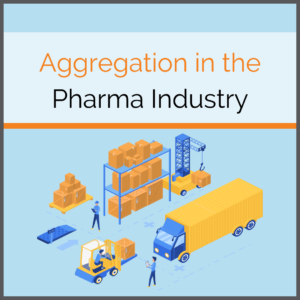
Products purchased in stores typically come in cardboard boxes, plastic film, cans, or bottles. This refers to primary packaging, which is the packaging that directly encases the product. For easier transportation, primary packaging is combined in larger packaging, for example, in a wine crate. This level is called secondary packaging. If you want to transport several secondary packages, you can combine them on a pallet. We are now at the tertiary packaging stage. Products are usually transported from wholesalers to retailers in this way. Some pharmaceutical regulations require linking information between the different packaging levels. By linking the serialization information at the various levels, the relationship between batches, for example, is mapped. This process is called aggregation. A parent-child relationship is created between the individual levels.
In the pharmaceutical industry, it is usually the primary level at which a product is serialized. If you go one packaging level higher, you speak of aggregation. While serialization is already common practice in most markets, aggregation is often not mandatory. However, it can majorly contribute to the supply chain and patient safety. The following article explains the benefits of aggregation, its challenges, and what the future of aggregation looks like.
Advantages of Aggregation
Aggregation offers numerous advantages. It improves the efficiency of the supply chain by enabling better traceability of products. As a result, this leads to increased safety for end consumers. It is also another step that can prevent counterfeiting in the supply chain. With aggregation, manufacturers have the opportunity to make recalls more efficient. Instead of only being able to identify the products on the individual primary packaging, it is also possible to intervene at the secondary and tertiary levels.
In case a specific medicine needs to be recalled, aggregation enables the affected batches to be identified more quickly. It should be kept in mind that, according to a report by the Healthcare Distribution Alliance, almost 60 million units of medication are recalled every year in the USA alone. In relation to these dimensions, aggregation can save a lot of time and money. Therefore, with the help of traceability through verification and reporting, safety can be improved along several steps of the supply chain.
What are the Challenges of Aggregation in the Pharma Industry?
Despite the many benefits, aggregation also brings challenges. These include the need for precise planning and implementation. The introduction of a new system such as aggregation has a major impact on existing workflows. Many additional serialization codes have to be created, printed, and scanned. These additional work steps cost time and, therefore, money. Unfortunately, the relationship between these costs and the potential savings is yet unknown.
Another challenge is the general implementation of new technologies. For example, if a pharmaceutical company wants to introduce an aggregation system, employees along the supply chain need to be trained in its use. Productivity may suffer at first, but this will improve over time.
Which Countries Make Pharma Aggregation Mandatory?
Despite its advantages for supply chain security, aggregation is only mandatory in relatively few countries. However, more are being added continuously. Aggregation is currently required in the following countries:
| Turkey (2014) | Egypt (2019) | Saudi Arabia (2020) |
| Russia (2020) | Qatar (2021) | India (2021) |
| Brazil (2022) | Bahrain (2022) | China (2022) |
| United Arab Emirates (2022) | Malaysia (2023) | USA (2023) |
These countries are in the process of introducing aggregation:
| Kazakhstan | Indonesia | Uzbekistan |
What Does the Future Hold?
The future of aggregation in the pharma industry looks promising. It is already mandatory in many large markets and is on the verge of being introduced in others. As technology evolves and digitalization increases, opportunities will arise to further expand aggregation. It will help to improve efficiency and security in the supply chain and make aggregation more attractive to legislators.
In the future, for example, we could expect even greater automation of aggregation processes. With advanced technologies such as artificial intelligence and machine learning, pharma companies could be able to greatly optimize and automate their processes.
To summarize, aggregation plays an important role in the pharma industry and is likely to become even more important in the future. It offers numerous advantages but also brings challenges that need to be overcome. With the right planning and implementation, aggregation can make a significant contribution to improving patient safety. It therefore remains to be seen which countries will follow suit with mandatory aggregation.